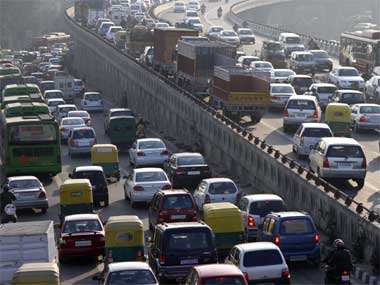Well, at least it’s a beginning. “Despite low turnout, the first ‘Car-Free Day’ in Mumbai was a success as the organisers of the event were able to spread the message of keeping the city free of pollution and traffic congestion. A 20-km ‘Car-Free Zone’ was created in South Mumbai as part of the event organised by Greenmile Foundation in association with Baramati Welfare Organisation. The event also featured competitions such as a 20-km ‘Bikeathon’ and a 10-km ‘Walkathon’ covering places such as Hutatma Chowk, Ballard Estate, Mantralaya, Nariman Point, Marine Drive and Girgaum Chowpatty,” reports Indian Express. [caption id=“attachment_141683” align=“alignleft” width=“380” caption=“A tax on driving in congested areas of Mumbai? Where can one drive at all without congestion? B Mathur/Reuters”]  [/caption] This one’s got us stumped – a tax on driving in congested areas. Where can one drive at all without congestion? “If the Centre’s plan materialises, you will have to pay for driving to crowded areas in the city. Congestion pricing will make traffic management easier, said the Centre, which plans to push for it during the annual road safety programme from January 1 to 7, 2012,” says DNA. If this becomes law, we don’t need Car-Free Days… Car Free Day, congestion tax and, now, a super-toll? “The country’s longest sea bridge is also likely to stake claim to another record. The Mumbai Trans Harbour Link (MTHL) is set to become the highest toll-generating project in the state, roping in a whopping Rs 1.1 crore as toll everyday,” says Hindustan Times. West is worse than east. “Most of the complaints received by the India Against Corruption (IAC) campaign against auto drivers were from harassed commuters in the western suburbs. Nine of the top 10 areas on the list were in the western suburbs. Barring Thane, which stood eighth on the list, all the other nine areas were between Bandra and Borivli. Andheri topped the list with a maximum of 287 complaints in just 10 days. Of these, 159 complaints were for auto refusals, 82 for rigged meters, 34 for excess fares demanded and nine for rude behaviour by auto drivers, especially when it came to dealing with senior citizens and women,” says Times of India. This is a different kind of private-public participation, “The extent of the fire that destroyed the Sara-Sahara complex and parts of Manish Market would have been much greater had it not been for the presence of mind of some youngsters. While the fire brigade was busy trying to put out the raging fire at the Sara-Sahara complex, the flames quickly spread to the neighbouring Al Quadri chawl. “Residents claimed that fire officials were unwilling to climb to the top of the chawl to douse the fire and this prompted them to hit the roof themselves. Since the fire was put out in time, approximately 200 homes were saved from being burned,” reports Times of India. Real estate majors are shying away from big deals. “When Standard Chartered and the Hongkong and Shanghai Banking Corporation Ltd opened sale bids recently for their five-storey residential building, Bishops Gate, in Breach Candy, they were in for a surprise. Unlike the frenzy witnessed in earlier high-profile land auctions of National Textile Corporation or Mumbai Metropolitan Region Development Authority, traditional developers like Lodha, Sheth, Runwals were conspicuous by their absence in this bid,” says Times of India. Are the investments in AIDS awareness paying off? “As Mumbai gears to observe World Aids Day on December 1, official data bring some cheer. The number of new Aids cases reported annually in the city has dropped 88.64% in the last five years: down to 595 till October 2011 from 5,240 cases reported in 2007,” finds Hindustan Times.
If the Centre’s plan materialises, you will have to pay for driving to crowded areas in Mumbai. Congestion pricing will make traffic management easier, said the Centre.
Anant Rangaswami was, until recently, the editor of Campaign India magazine, of which Anant was also the founding editor. Campaign India is now arguably India's most respected publication in the advertising and media space. Anant has over 20 years experience in media and advertising. He began in Madras, for STAR TV, moving on as Regional Manager, South for Sony’s SET and finally as Chief Manager at BCCL’s Times Television and Times FM. He then moved to advertising, rising to the post of Associate Vice President at TBWA India. Anant then made the leap into journalism, taking over as editor of what is now Campaign India's competitive publication, Impact. Anant teaches regularly and is a prolific blogger and author of Watching from the sidelines. see more


)
)
)
)
)
)
)
)
)



